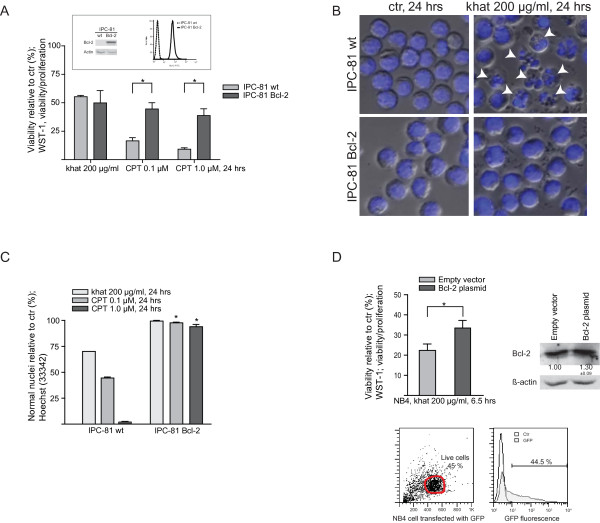Figure 4.
Over-expression of Bcl-2 provided protection against CPT while only partly inhibiting khat-induced cell death. IPC-81 parental and IPC-81 Bcl-2 rat leukemia cell lines were exposed 200 μg/ml khat and 0.1 μM CPT for 24 hrs and evaluated for toxic effects. (A) Effects on cell viability/proliferation were assessed using the WST-1 assay. The results were collected by measuring absorbance (450 nm - 620 nm) and are presented as: [(absorbance treated cells)/(absorbance control cells)] × 100. The figures in the insert demonstrate the different Bcl-2 protein levels in the two IPC-81 cell lines based on Western blotting and flow cytometry. The differences in CPT sensitivity between IPC-81 parental and IPC-81 Bcl-2 were statistical significant as indicated by the asterisk (p < 0.05). (B) The pictures of Hoechst stained IPC-81 parental and IPC-81 Bcl-2 cells following treatment with khat shows that khat only affected the IPC-81 parental cells. The arrows indicate the presence of cell fragmentation. (C) Effects on nuclear morphology were determined following Hoechst staining using epifluorescent microscopy. The results are presented as percentages cells with normal nuclear morphology as compared to controls. The differences in CPT sensitivity between IPC-81 parental and IPC-81 Bcl-2 were statistical significant (p < 0.05). (D) The NB4 cell line was transiently transfected with either an empty vector, a GFP-encoding control plasmid or a Bcl-2 plasmid and exposed to khat (200 μg/ml, 6.5 hrs) 24 hrs after transfection. Effects on cell viability/proliferation were assessed using the WST-1 assay showing a statistical significant protection against khat in the Bcl-2 transfected cells (p = 0.05).

